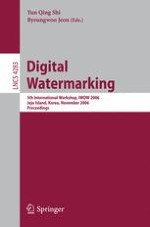Welcome to the proceedings of the Fifth International Workshop on Digital Watermarking (IWDW). Since the first IWDW held in Seoul, Korea in 2002, it has been a focal point for meeting in person and disseminating valuable scientific and technological developments in watermarking. IWDW 2006 was held on Jeju, the dream island in Korea. The main theme of the workshop was “Meet the Challenges in this Digital World!” As we all know, digital watermarking and its related technologies have emerged as the key ingredients of this digital world. We report on new developments and discuss how to best utilize the watermarking and its related new technologies to cope with many challenging issues in this digital world. This year, we accepted 34 papers out of 76 highly qualified submissions from 14 different countries. Each paper was reviewed by three reviewers. The acceptance ratio of 44% indicates IWDW’s continuing commitment to ensuring the quality of the workshop. In addition, we had three invited lectures and one panel discussion that shed invaluable insights to the watermarking community on new developments and future directions. The technical program featured such topics as steganography and steganalysis, data forensics, digital right management, secure watermarking, and their applications. The 34 accepted papers, three invited lectures, and the panel discussion covered both theoretical and practical issues that all of us can benefit from. Furthermore, 13 of the 34 papers were arranged in a poster session in order to facilitate more efficient and interactive information exchange.
